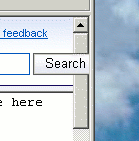
During development at http://www.gigya.com my markup produced the phenomenon you can see in the screenshot to the right. A button input element has successfully climbed over the scrollbar of my IE 6.0.2900.2180.
The markup is far from trivial and efforts to recreate this with simple HTML have failed (Note that I only put about 5 minutes into this attempt.
IMHO this is a nice bug,
Anybody knows who should I report it to ?
I wander, does MS send a T-Shirt saying "I found a bug in ..." for this ?
or maybe when you discover a bug in IE its the firefox people that send you the T-Shirt :)
Anyway, I will try and reproduce this with simple markup,
Till then, think of it as a challange.
Tuesday, September 26, 2006
To boldly go where no one has gone before.
Monday, September 18, 2006
Ajax.Net Pro: System.NotSupportedException exception - TAKE 2
Just after posting my previous entry about this issue,
I got a response from michael Schwarz.
It turns out that if you do not wish to convert to a web application project you can resolved the issue I described via using appripriate configuration changes in web.config.
In your web.config add a urlNamespaceMapping:
<ajaxNet>
<ajaxSettings>
<urlNamespaceMappings useAssemblyQualifiedName="false">
<add type="Namespace.Class,AssemblyName" path="mypath"/>
</urlNamespaceMapping>
</ajaxSettings>
</ajaxNet>
If you are using the App_Code folder for your class you can use the
AssemblyName "App_Code" for this.
Thank you Michael.
Note: Even though this is a much less painful solution,
I am not sorry we migrated to a web application,
it has other benefits that make the effort worth while.
Ajax.Net Pro: System.NotSupportedException exception.
A while ago We encountered a technical problem with Ajax.Net Pro.
The problem is fully described in here but the short story was that after we did all we can to create an application that does not maintain any state on the server side, it seemed like Ajax.Net was doing just that, and in doing so throws an exception:
{"Message":"This method is either not marked with an AjaxMethod or is not
available.","Type":"System.NotSupportedException","Stack":null,"Source":null}
This would happen when a an application running while a new version deployed on our server and then an Ajax call was made to the server.
luckily for us just a few days ago the code for the current Ajax.Net was made public by its creator Michael Schwartz.
Having the code available we quickly found out that the problem was that since we where using a "WebSite" .Net project in our development, each time the assembly was compiled it got a different name, something like "App_Web_59e2jzgq.dll", this is serialized to the client and used on the call back.
The solution to the problem was to move to Microsoft's new yet old Web Application project model.
The migration process is explained quite well in here:
http://webproject.scottgu.com/CSharp/Migration2/Migration2.aspx
This causes the assembly name to loose its random part and thus can be referenced again by the information serialized to the client even after re-deployment.
(of course you have to make sure your interfaces remain compatible.)
Wednesday, September 13, 2006
my Pizza got lost on an HTTP Redirect

Well, Imagine the following scenario:
You order a pizza with all the toppings you like.
Then you get invited to watch a game with your neighbours.
You leave a note on the door saying something like:
"Dear Pizza delivery guy,
We are at the neighbours one floor below - apt. 16, Thanks!"
and of you go to your neighbours to watch that game.
30 min. later more or less, there is a knock on the door,
hmm... I wander who could that be - Yep you guessed right,
Its the Pizza delivery guy!
However - That's wired - Where is the pizza? so naturally you ask him:
"hmm... - Where is my pizza ?"
The delivery guy explains that it is company policy that if there is a note on the door the delivery guy should go to where is indicated in the note but "the delivery guy MUST NOT automatically take the pizza with him unless it can be confirmed by the person who ordered the pizza, since this might change the conditions under which the pizza was ordered."
I don't know about you, but when I leave such a note on the door, I expect the pizza to be redirected with all the toppings.
It might sound wierd when talking about pizzas, IMHO it is not less wierd when talking about HTTP POST Requests that get a response from the 3xx family.
I realy see no security issue with redirecting the pizza, sorry - the post data, to any address the recieving server asked it to be redirected to. After all you have the data was available for that server and he could just take it an send it (back-end) to anywhere he likes. If I trust that site then by transitivity I trust any other site he trusts - not to mention the fact that more often then not it will be just another appartment in the same building, sorry again - another URL in the smae domain.
Now where is my pizza ?!
note: pizza company policy adopted more or less from http://www.w3.org/Protocols/rfc2616/rfc2616-sec10.html#sec10.3
one last note - I would agree that a request that was sent using HTTPS should not be allowed to be redirected to a non-HTTPS addres for safty reasons. This is just to make sure the pizza remains hot.
